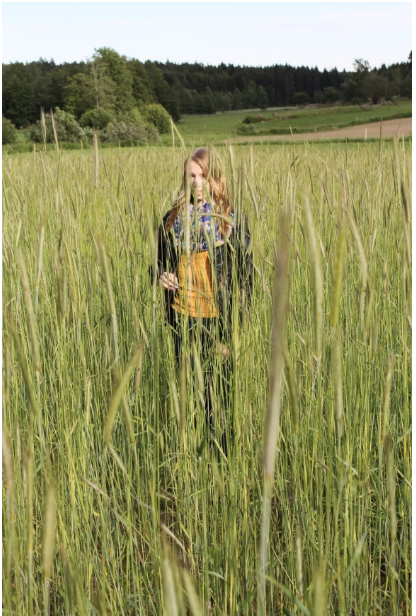Crop: Secale cereale L. (Rye)
The landrace called ‘Hermanni, is cultivated as winter rye in one farm located in South East Finland (Kymeenlaakso region) in the most south-eastern municipality in Finland. The municipality is bounded in the east by Russia and in the south by the Gulf of Finland.
As common to landrace rye it has long straw (180-190 cm), small grain, low yielding capacity, good winter-hardiness and yield reliable over different growing seasons.
Cultivation System: organic conditions.
Geographical Information
Country: Finland
The landrace is cultivated in one organic farm located in South East Finland (Kymeenlaakso region) in the most south-eastern municipality in Finland. The municipality is bounded in the east by Russia and in the south by the Gulf of Finland. The field is situated 15 m a.s.l.
Farmer(s) description:
The farmer cultivates ‘Hermanni’ and some other landraces such as potato onion and six-row barley to maintain both traditions and landraces alive. ‘Hermanni’ has been cultivated at least from 1950s in the farm. The yield has been used in home consumption until the year 2016 when it was registered as a conservation variety. In 2018 its cultivation area was 35 acres and the yield obtained was about one thousand kilos. Earlier it was cultivated every second or third year because the entire yield was used in farm. Last three years it has been sown every autumn in order to get more yields for small niche markets. After saving the seeds for the next sowing grains are milled in a small mill. (Hermanni farmer interview 2018).
Propagation system: Seed, cross-pollination
Multiplication procedures and consequences on landrace diversity:Because rye is a cross-pollinating plant, different varieties need to be cultivated far enough from each other, at least a safety zone of 0.5 km and preferably one kilometre is needed. The farmer does not cultivate other rye varieties than ‘Hermanni’ and takes the neighbours' fields into account in the cultivation plan (Hermanni farmer interview 2018).
Management plan existence:As a registered conservation variety with a special maintenance subsidy paid, used farming methods must ensure that it is not mixed to other varieties and there will not be any undesirable cross-pollination. The maintainer needs also to keep a record book on cultivation and storing. Maintenance is controlled by Finnish Food Authorities by field inspection and post-control testing once in five years. (Finnish Food Authorities 2019b).
Added Values
Due to the marginal cultivation area only some kilos of yield have been sold so far. However, since 2018 an artisan bakery has tested to bake a speciality rye bread to buy from their bakery cafe. (Hermanni farmer interview 2018).
Others (e.g. commercial/geographical brands or special traits):‘Hermanni’ is registered in Finland as a conservation variety in the European Common Catalogue of Conservation Varieties (EU Plant variety database 2019) in 2016 (Finnish Plant Variety Journal 2019). The modified DUS-test is done during the registration process.
As registered a conservation variety, the farmer can apply for subsidies for the maintenance. It is paid by the Finnish Ministry of Agriculture and Forestry under environmental subsidies. In order to get the subsidy, the maintainer need to grow a registered conservation variety during the five year period to keep seed alive and have it stored for two years use. Farmer can decide to grow it yearly or less. (Finnish Food Authority 2019b).
The farmer appreciates high the subsidy although it is small in terms of money because it shows appreciation on maintenance work done by farmers. He hopes for a national wide promoting campaign to show in the society the importance of in situ maintenance work for biodiversity, and to increase consumer demand for specialty products. (Farmer interview 2018.)
The genetic diversity and secondary metabolites of ‘Hermanni’ comparing it to other rye landraces in situ will be analysed in the ongoing Finnish rye sourdough project. Furthermore, secondary metabolises, microbial dynamics and Lactabacillus species will be studied from the old sourdough used in baking ‘Hermanni’ rye bread and compared to other old rye sourdoughs. (Luke project 2018-2020).
The status as conservation variety, the subsidy for maintenance and the agreement with an artisan bakery for a ‘Hermanni’ rye bread has inspired and encouraged the farmer for cultivating ‘Hermanni’ yearly in increased field area. The farm family is exceptionally proud of their landraces. For now, ‘Hermanni’ is cultivated in one farm because of limited seed material to sell and with small amount of seed (some kilos) seed backing performed along with the appointed standards is difficult if not impossible.
This landrace is registered in Finland as a conservation variety in the European Common Catalogue of Conservation Varieties.
Case study provided by Natural Resource Institute (LUKE), Finland. Most of information were provided by Maarit Heinonen.
- EU Plant variety database (2019)
- Finnish Food Authority (2019a) Statistics database.
- Finnish Food Authority (2019b) Conservation varieties. https://www.ruokavirasto.fi/yritykset/kasviala/Lajikkeet-ja-alkuperaiskasvit/alkuperaiskasvit/
- Finnish Plant Variety Journal (2019) Food Authority 2019:4. https://www.ruokavirasto.fi/globalassets/tietoa-meista/julkaisut/suomen-kasvinlajiketiedote/tiedote_2019_4.pdf
- Hermanni farmer interview (2018) Interview on 4th October 2018. Interview data is kept in Luke.
- Luke project (2018-2020) Microbial biodiversity in Finnish rye sourdough. Project page https://www.luke.fi/en/projects/ruista/
